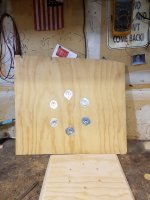76SeaRay
Lieutenant Junior Grade
- Joined
- Aug 24, 2017
- Messages
- 1,071
In the past when I was young and dumb, I broke a few stainless screws trying to put them into fiberglass on the sailboat that I had at that time. Later I found out that the screws will bind in the fiberglass without the right size pilot hole. Is there a table of screw size versus pilot hole sizes for fiberglass applications as I am assembling my hardtop and mounting the horns, lights, antennas, etc.? I have drilled out the mounting holes and refilled them with thickened epoxy so that they are waterproof when I put the screws into them. I will use screws that are short enough to not go all the way through the epoxy plug.
Thanks....
Thanks....























